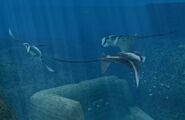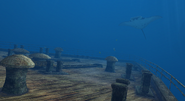← Japanese Eagle RayEndless Ocean Creatures
Endless Ocean 2 CreaturesJapanese Bullhead Shark →
Bottlenose Dolphin →
The manta ray (Manta birostris) is a large species of ray found in Endless Ocean and Endless Ocean 2.
M. birostris and its sister species are highly famous species of rays, easily recognizable due to their large size and distinctive black-and-white coloration.
In-Game[]
Marine Encyclopedia[]
Endless Ocean[]
Description[]
"These fish have thin bodies with long diamond shapes, large mouths, and narrow tails. Their back portions are black, while their bellies are white with black spots. They can be seen all over Manoa Lai at any time of year.
It is thought that the name manta, which means "blanket" in Spanish, was given to these creatures because of their shape. The unusual fins on the left and right of their mouths evolved from pectoral fins. There is a large amount of variation in the speckled markings on the underside. In fact, some specimens are completely black.
The largest mantas can have a 25-foot wingspan and weigh over 3 tons. Despite their massive size, they have been known to leap out of the water. It is thought that this behavior is either caused by fear or is an attempt to detach a particularly stubborn parasite."
Endless Ocean 2[]
Description[]
"Well known to the general public as well as to divers, this is the world's largest ray. Each manta ray has a unique pattern of black spots on its stomach that helps to tell them apart. These black spots can spread across the entire stomach, making some manta rays appear entirely black. They sometimes jump out of the water, but this is thought to be because they are startled or trying to remove parasites."
[ Looks Cozy? ][]
"The word 'manta' also means blanket or cloak, which fits its large, flat body. It has distinctive fins on either side of its mouth, developed from pectoral fins. These look like horns, so the manta is also known as the devilfish."
Location[]
Endless Ocean[]
A singular manta ray can be seen in the Lagoon, where it is the largest form of sea life, though it is replaced with a green sea turtle at night. A large shoal can be seen swimming above the sunken ship in Ship's Rest; however, they are also only there during the day.
Endless Ocean 2[]
Two mantas can be found in Gatama Atoll at coordinates C-3, and are the only mantas in either game that can be found by both day and night.
During the day, a group of mantas can also be found in western Ciceros Strait, inhabiting Amphitrite's Sanctuary around C-5; these are replaced by hammerhead sharks at night. A large shoal can also be found in the South Canyon, swimming in and out of the map in a circular cycle.
A lone specimen can also be seen just outside the Cavern of the Gods during the opening cutscene, as well as during normal gameplay when the ruins are first discovered. However, he is not a permanent resident and does not appear there after the final chapter has been completed.
A single manta ray can also be attracted to the Private Reef if at least three Deity Statues are placed.
Behavior[]
Manta rays swim in slow circles, patrolling the areas they live in. They do not interact with any other creatures but enjoy being stroked. In Endless Ocean 2, their trivia can be gained by taking a picture of them.
Gallery[]
Notes[]
- At C-3 in Gatama Atoll, if the player focuses on either manta ray while on their first guided-tour with Owa, he tells them that the pair is known as Mana and Kai.
- Notably, a manta ray appears on the box art for the first Endless Ocean, and a school of them appears in the game's Wii Menu icon.
- A manta ray is the subject of the very first photo request the player will receive in Endless Ocean 2.
Real-Life Information[]
- These rays are classified as a vulnerable species on the International Union for the Conservation of Nature's Red List[1]. The greatest current threat to these rays is overfishing, as they are a species known to stay concentrated in areas where food is plentiful as opposed to spreading out.
- Additionally, their liver oil and skin are occasionally sought after; their meat is also edible, and eaten in certain countries. However, it is considered less desirable than the flesh of other fish, and has been reported to retain the taste of seawater[2]. The most important part is often considered to be the gill rakers, which are used in traditional Chinese medicine[3][4].
- Due to manta rays being endangered, trying to sell their meat is an arrest-worthy offense in some places, such as the Philippines[5].
- Manta rays have been known to reach a maximum recorded size of 29 feet (8.8 meters), averaging out at about 22 feet (6.7 meters)[6][7][8]. This means that the mantas seen in-game are relatively small in comparison.
- Mobula birostris, the species of ray featured in the games, is one of two species of manta ray recognized today, alongside M. alfredi, the reef manta ray[9].
- Originally, M. birostris and M. alfredi were both classified as Manta birostris (as named in-game) and Manta alfredi, belonging to the genus of Manta. However, following a study published in 2017, the Manta genus was reclassified as a nominal species of Mobulidae -- in other words, the two manta species have now been reclassified as Mobula birostris et. alfredi[10].
- Another common name for M. birostris, the species seen in-game, is the giant oceanic manta ray, though the "giant oceanic" part of the moniker is usually omitted to simply call them "manta rays"[11]. They also have the nickname devil fish, due to the two fins protruding from the front of their heads that resemble horns[8].
- These fins are known as cephalic lobes[7].
- Manta rays have been known to live up to 50 years of age[8]. Their long lifespans and low rate of reproduction, combined with overfishing, results in a slow decline of manta populations across the globe.
- To rid themselves of small parasites on their skin, like tiny copepods, manta rays will often visit "cleaning stations" in coral reefs, where small fish like cleaner wrasses clean them up as they would any other large creature[8].
- While groups of manta rays are often simply referred to as "shoals", as with groups of other fish, a gathering of rays may be referred to as a "squadron" or a "fever"[12][13][14].
- Manta rays are known to be incredibly intelligent as far as fish go - they have the biggest brains of any fish studied so far, and tests have shown that they recognize themselves in mirrors[15][16]. They are the first fish to ever have been recorded doing so[17].
- The test of whether or not a creature recognizes itself in the mirror is commonly known as the "mirror test"[18]. It is used to determine whether or not the animal in question can recognize themselves visually, which is often used as a cue that the animal may possess self-awareness, a trait that comes with higher brain functioning[19].
[]
Red Sea Bream
• Asian Sheepshead Wrasse
• Golden Trevally
• Giant Trevally
• Largehead Hairtail
Pilotfish
• Mahi-Mahi
• Antarctic Toothfish
• Longtooth Grouper
• White Grouper
• Humphead Wrasse
Giant Grouper
• Great Barracuda
• Meagre
• Bartail Flathead
• Atlantic Tarpon
• Atlantic Bluefin Tuna
Chinook Salmon
• Striped Marlin
• Indo-Pacific Sailfish
• Olive Flounder
• Coelacanth
• Red Cornetfish
European Conger Eel
• Great White Shark
• Scalloped Hammerhead
• Sand Tiger
• Greenland Shark
Tiger Shark
• Whale Shark
• Basking Shark
• Pelagic Thresher Shark
• Great Sturgeon
Bowmouth Guitarfish
• Dwarf Sawfish
• Remora
• Whitetip Reef Shark
• Banded Houndshark
• Epaulette Shark
• Zebra Shark
• Tasselled Wobbegong
• Japanese Bullhead Shark
Blotchy Swell Shark
• Cloudy Catshark
• Japanese Angelshark
• Japanese Eagle Ray
• Manta Ray
References[]
- ↑ IUCN Red List
- ↑ Phoenix New Times
- ↑ Manta Ray World
- ↑ Planet Experts
- ↑ Inquirer
- ↑ Florida Museum
- ↑ 7.0 7.1 Oceana
- ↑ 8.0 8.1 8.2 8.3 National Geographic
- ↑ Wikipedia (Manta Ray)
- ↑ Linnean Society of London
- ↑ Wikipedia (M. birostris)
- ↑ Discover Wildlife
- ↑ Florida Aquarium (Facebook)
- ↑ Research Maniacs
- ↑ Springer Link
- ↑ School of Marine and Environmental Affairs
- ↑ New Scientist
- ↑ Science Daily
- ↑ Wikipedia (Mirror Test)













